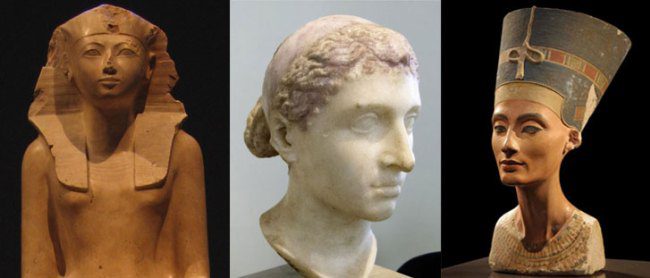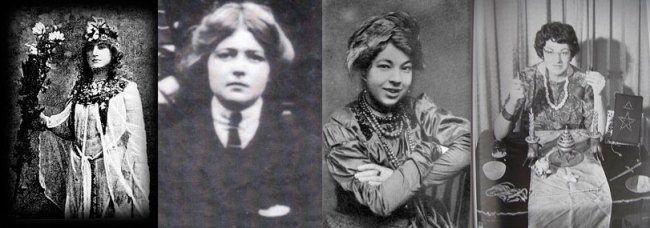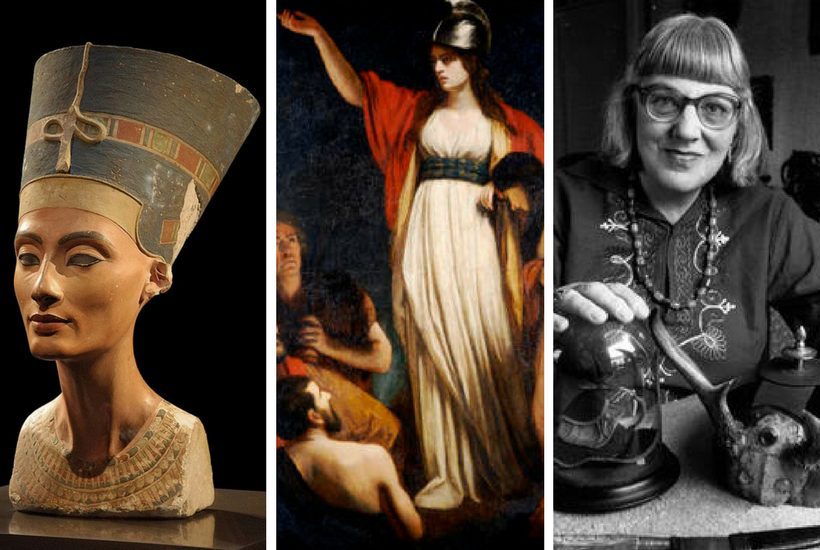Today is International Women’s Day, a day in which we celebrate, appreciate, and highlight women’s economic, political, and social achievements. Here are some queens, warriors, scholars, and visionaries who have influenced or inspired contemporary Paganism and Witchcraft.

The queens of Egypt
Men have generally dominated the political arenas for the better part of human history. Women have done the best they could as wives, mothers, and mistresses. History remembers few of them.
Neferneferuaten Nefertiti (ca. 1370 – ca. 1330 BCE) was the Great Royal Wife of the pharaoh Akhenaten. They ruled the wealthiest period of Ancient Egyptian history but are better known for a religious revolution. Akhenaten and Nefertiti worshipped one god only, Aten, or the sun disc.
Nefertiti was made famous by her bust, now in Berlin’s Neues Museum. The figure is one of the most copied works of ancient Egypt, and it solidified her iconic status. After Cleopatra, she is the second most recognisable or famous queen of Egypt.
Hatshepsut ( 1508–1458 BCE) was the fifth pharaoh of the Eighteenth dynasty of Egypt. She was one of the most successful pharaohs and reigned longer than any other woman of an indigenous Egyptian dynasty. According to Egyptologist James Henry Breasted, she is also known as “the first great woman in history of whom we are informed.”
Hatshepsut established trade networks and expeditions and maintained a peaceful foreign policy. The great wealth she brought to Egypt enabled to her become a prolific builder, commissioning hundreds of construction projects that included buildings and statuary. She raised the calibre of Ancient Egyptian architecture to a new standard that any other culture would not rival for a thousand years. So much was produced during her reign that almost every major museum globally has Hatshepsut statuary among its collection.
Cleopatra VII Philopator (69 – 12 August 30 BCE) was the last active Pharaoh of Ancient Egypt. She represented herself as a reincarnation of Isis and, although she was said to be extraordinarily beautiful, Plutarch and Cassius Dio wrote that it was her wit, charm, and “knowledge of how to make herself agreeable to everyone” that made her special. She was brilliant to listen to as well as to look upon. Cleopatra captured the public imagination like no other and is invariably the Queen of Egypt and the Pagan Queen par excellence.

The warriors and scholars of antiquity
Sappho (born between 630 and 612 BCE and died around 570 BCE) was a Greek lyric poet born on the island of Lesbos. We know very little about her life. Her poetry was well-known and greatly admired in antiquity but is largely lost to us. However, her reputation has endured. Sappho’s work centres on love and passion for people of both sexes. Her name gave us the word “sapphic”, and “lesbian” derives from the name of the island of her birth. Sappho and her work are an inspiration for LGBTIQ+ Pagans.
Artemisia I of Caria ( fl. 480 BCE) was the queen of Halicarnassus and is best known for fighting for her overlord Xerxes I, King of Persia, against the free Greek city-states during the second Persian invasion of Greece. She commanded her contribution of five ships at naval battles and was praised for her courage and the great respect King Xerxes I had for her.
Boudica (d. 60 or 61 CE) was the queen of the British Iceni tribe, a Celtic tribe who led an uprising against the occupying forces of the Roman Empire. Ultimately, the Romans defeated the Celts. We don’t know how Boudica died, and she was largely forgotten until the Victorian era when her fame took on legendary proportions.
Hypatia (born c. 350 – 370 and died 415 CE) was a mathematician, astronomer, and philosopher in Egypt, then a part of the Byzantine Empire. Remarkably, she was the head of the Neoplatonic school at Alexandria. A Christian mob murdered Hypatia after she was accused of exacerbating a conflict between the governor and bishop of Alexandria. Naturally, she was labelled a witch by her attackers. Hypatia is a powerful symbol and inspiration for many Pagans today. For example, she is the guardian ancestor of Cherry Hill Seminary.

The modern visionaries
In modern occultism, men such as Eliphas Levi, Samuel Liddell MacGregor Mathers, A.E. Waite, Aleister Crowley, Israel Regardie, and Gerald Gardner get the spotlight. However, many notable women have made significant contributions to Paganism, Witchcraft, and occultism and continue to teach and inspire us today.
Moina Mathers (28 February 1865 – 25 July 1928) might best be known as the wife of Samuel Liddell MacGregor Mathers, one of the founders of the organisation Hermetic Order of the Golden Dawn. Moina was a talented artist and occultist, a seeress who illustrated what her husband evoked. After his death, she became head of a successor organisation, the Rosicrucian Order of the Alpha et Omega.
Dion Fortune (6 December 1890 – 8 January 1946) was a prominent British occultist, author, psychologist, teacher, artist, and mystic. She founded the Fraternity of the Inner Light, an occult organisation that survived her and has spawned related groups. Fortune was a prolific writer. Psychic Self-Defense, The Training and Work of an Initiate, The Mystical Qabalah, The Secrets of Dr. Taverner, The Sea Priestess, and Moon Magic are just a few of her influential books.
Pamela Colman Smith (16 February 1878 – 18 September 1951) was a British artist, publisher, and occultist. Known as Pixie, Smith co-created the famous Waite-Smith deck of tarot cards. Her name didn’t appear on the title of the deck, which was published initially simply as Tarot Cards and later as The Rider Tarot Deck (after the publishing house) and later still as The Rider-Waite Tarot. Pixie was a member of the Golden Dawn who converted to Catholicism and may have been into Marian devotion. She was a visionary artist rediscovered today and appreciated anew.
Doreen Valiente (4 January 1922 – 1 September 1999) is perhaps the most influential Wiccan woman. Initiated by Gerald Gardner, she wrote much of the early Gardnerian religious liturgy and played a big part in bringing Wicca to wider public attention. Considered the mother of modern Witchcraft, she produced the most enduring inspirational Wiccan text, the Charge of the Goddess.

